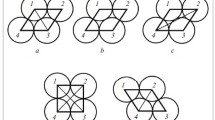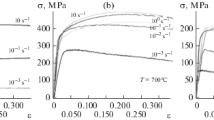Abstract
The dilatometric method was used to study the deformation arising in iron and iron-nickel alloys containing up to 20% nickel upon the α → γ → α transformation cycles at a small compression load. At a constant load, a decrease in the heating rate leads to an increase in the dilatometric effect of the α → γ transformation by a factor of three, from a one third of the volume effect of transformation upon rapid heating to its full value upon slow heating. An inverse effect, i.e., a decrease in the degree of deformation that is developed upon the transformation, is caused by the alloying of iron with nickel. The anomalous plasticity observed upon the polymorphic transformation is related to the fact that the external stresses climinate spatial degeneration and produce a preferred direction for the relization of dimensional changes caused by the volume effect of transformation.
Similar content being viewed by others
References
E. I. Estrin, “Interaction between Deformation and Phase Transitions,” Izv. Akad. Nauk, Ser. Fiz. 69(9), 1248–1258 (2005).
E. Scheil, “Uber die Umwandlung des Austenits in Martesite in Eisen-Nickel-Legirungen unter Belastung,” Z. Anorg. Allg. Chem. 207(1), 21–40 (1932).
V. F. Zackey, E. R. Parker, D. Fahr, and R. Busch, “The Enhancement of Ductility in High-Strength Steels,” ASM Trans. Q. 60(1 (1)), 252–259 (1967).
Yu. G. Virakhovskii, I. Ya. Georgieva, Ya. B. Gurevich, et al., “Using Martensitic Transformation Caused by Deformation to Obtain Plasticity in Austenitic Steels Strengthened by Thermal Hardening,” Fiz. Met. Metalloved. 32(2), 348–363 (1971).
I. Ya. Georgieva, “TRIP Steels as a New Class of High-Strength Steel with Increased Plasticity,” Metalloved. Term. Obrab. Met., No. 3, 18–26 (1976).
I. Ya. Georgieva, “High-Strength Steels with a Plasticity Induced by Martensitic Transformation,” in Itogi Nauki Tekh., Ser: Metalloved. Term. Obrab., (VINTI, Moscow, 1982), Vol. 16, pp. 69–105.
A. P. Gulyaev, Superplasticity of Steel (Metallurgiya, Moscow, 1982) [in Russian].
V. A. Pimenov and E. I. Estrin, “Mechanical Properties of Iron near the α-γ Transformation,” Fiz. Met. Metalloved. 99(2), 100–104 (2005) [Phys. Met. Metallogr. 99, 212–216 (2005)].
E. I. Estrin and B. M. Mogutnov, “Mechanical Properties of High-Carbon Alloy Steel near the Phase-Transformation Temperature,” Dokl. Akad. Nauk 397(3), 330–333 (2004) [Dokl. 49, 422–425 (2004)].
L. F. Porter and P. C. Rosenthal, “Effect of Applied Tensile Stress on Phase Transformations in Steel,” Acta Metall. 7(7), 504–514 (1959).
M. de Jong and G. W. Rathenau, “Remarks on the Alpha-Gamma Transformation in Pure Iron,” Acta Metall. 9, 889–892 (1961).
F. W. Clinard and O. D. Sherby, “Strength of Iron during Allotropic Transformation,” Acta Metall. 12(8), 911–919 (1964).
G. W. Greenwood and R. H. Johnson, “The Deformation of Metals under Small Stress during Phase Transformations,” Proc. R. Soc. London, A 283 (1394), 403–423 (1965).
E. I. Estrin, “Dilatometer with a Variable-Induction Pickup for Studying Phase Transformations,” Zavod. Lab., No. 3, 368–370 (1966).
M. Hansen and K. Anderko, Constitution of Binary Alloys (McGraw-Hill, New York, 1958; Metallurgizdat, Moscow, 1962).
V. A. Zaimovskii and S. A. Faldin, “Shape Memory Effect Caused by the Structure Heredity and Bainite Transformation under Stress,” Fiz. Met. Metalloved. 58(1), 106–112 (1984).
I. V. Nosova, V. V. Sushok, and E. I. Estrin, “Mechanical Properties of Iron-Nickel Alloys in the Temperature Range of γ-α Transformation,” in Basic Physics of Formation of Physicochemical Properties of Steel and Alloys (Metallurgiya, Moscow, 1990), pp. 97–101.
Author information
Authors and Affiliations
Additional information
Original Russian Text © E.I. Estrin, 2006, published in Fizika Metallov i Metallovedenie, 2006, Vol. 102, No. 1, pp. 795–800.




